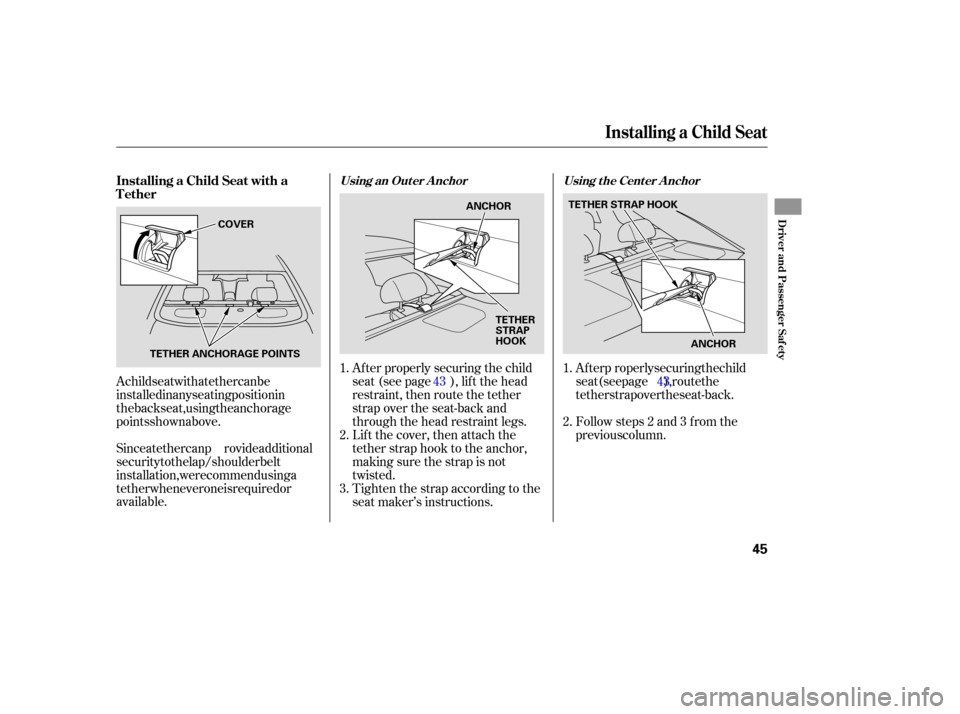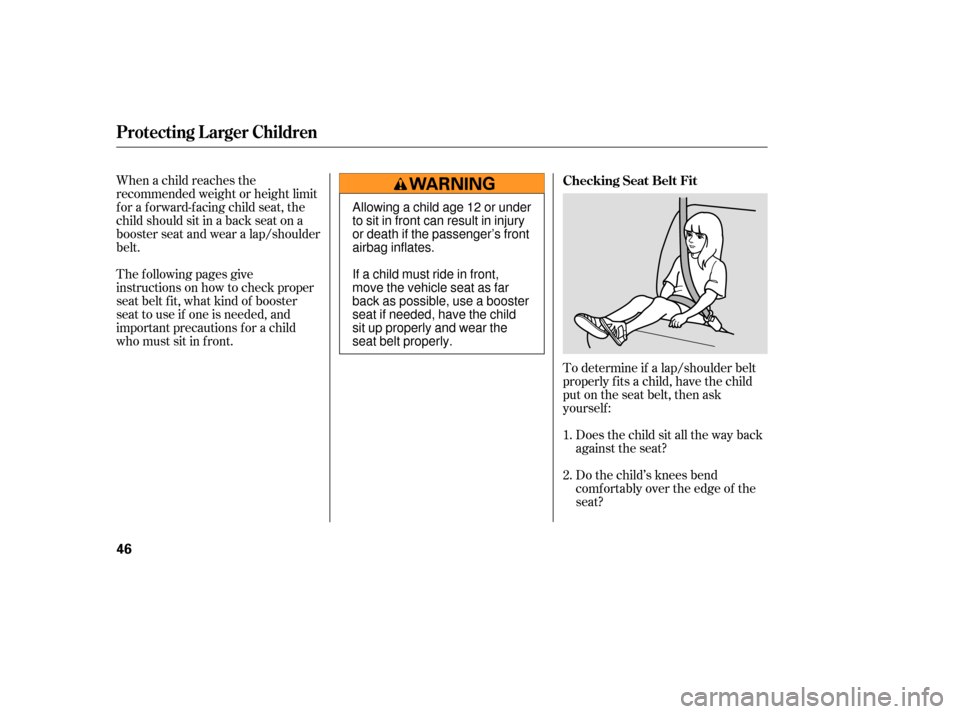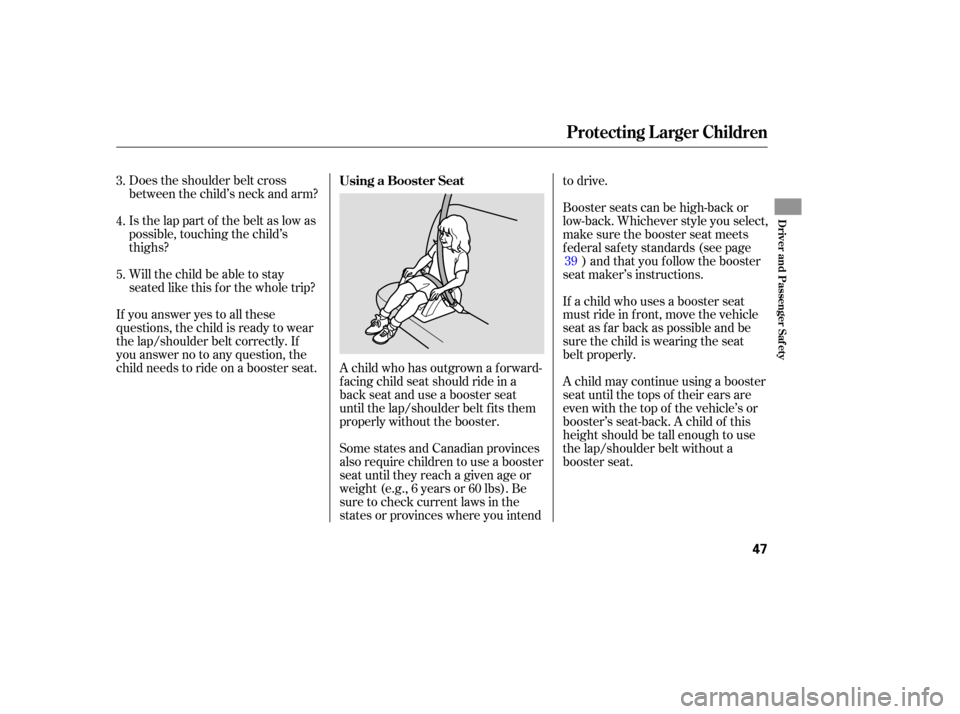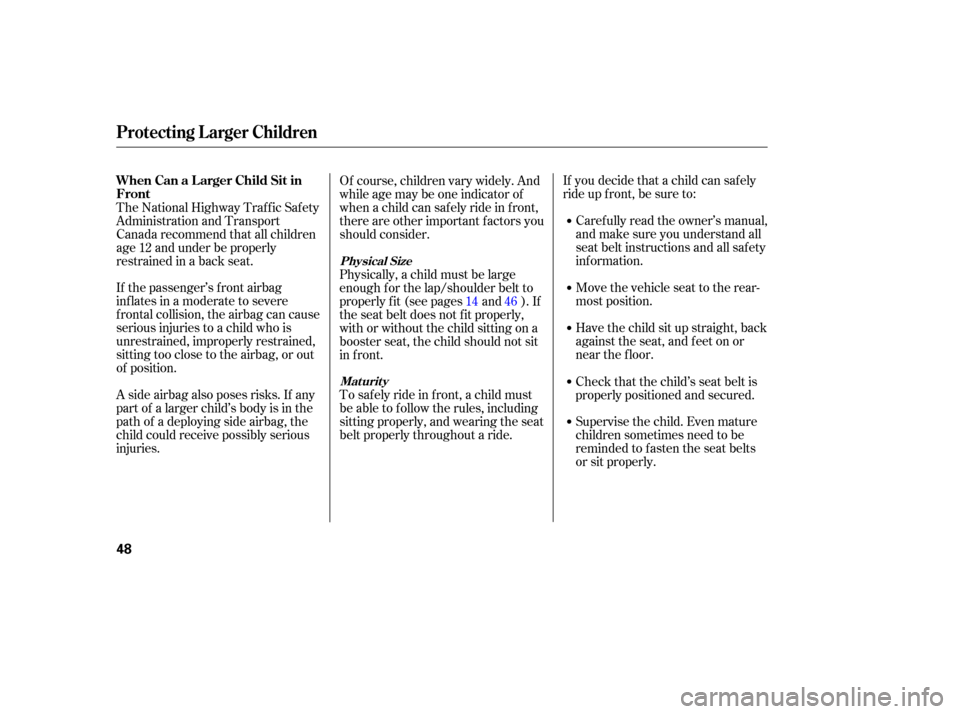Page 46 of 319
To deactivate the locking
mechanism and remove a child seat,
unlatch the buckle, unroute the seat
belt, and let the belt f ully retract.
Push and pull the child seat
f orward and f rom side-to-side to
verify that it is secure enough to
stay upright during normal driving
maneuvers. If the child seat is not
secure, unlatch the belt, allow it to
retract f ully, then repeat these
steps.
Af ter conf irming that the belt is
locked, grab the shoulder part of
the belt near the buckle, and pull
up to remove any slack from the
lap part of the belt. Remember, if
the lap part of the belt is not tight,
the child seat will not be secure.
To remove slack, it may help to
putweightonthechildseat,or
push on the back of the seat while
pulling up on the belt. 5.
4.
Installing a Child Seat
44
�����—�����—�����y�
�������������y���
�(���%�������y���������y
Page 47 of 319

A child seat with a tether can be
installed in any seating position in
the back seat, using the anchorage
points shown above.
Since a tether can provide additional
security to the lap/shoulder belt
installation, we recommend using a
te ther whenever one is required or
available. After p
roperly securing the child
seat (see page ), route the
tether strap over the seat-back.
Followsteps2and3fromthe
previous column.
After
properly securing the child
seat (see page ), lift the head
restraint, then route the tether
strap over the seat-back and
through the head restraint legs.
Lift the cover, then attach the
tether strap hook to the anchor,
making sure the strap is not
twisted.
Tighten the strap according to the
seat maker’s instructions.
1.
2.
3.
1.
2.
43 43
Installing a Child Seat with a
Tether
Using t he Cent er A nchor
Using an Out er A nchor
Installing a Child Seat
Driver and Passenger Saf ety
45
ANCHOR
TETHER
STRAP
HOOK TETHER STRAP HOOK
ANCHOR
TETHER ANCHORAGE POINTS COVER
�����—�����—�����y�
�������������y���
�(���%�������y���������y
Page 48 of 319

When a child reaches the
recommended weight or height limit
for a forward-facing child seat, the
child should sit in a back seat on a
booster seat and wear a lap/shoulder
belt.To determine if a lap/shoulder belt
properly f its a child, have the child
put on the seat belt, then ask
yourself :Does the child sit all the way back
against the seat?
Do the child’s knees bend
comf ortably over the edge of the
seat?
The f ollowing pages give
instructions on how to check proper
seat belt f it, what kind of booster
seat to use if one is needed, and
important precautions f or a child
who must sit in f ront.
1.
2. Checking Seat Belt Fit
Protecting L arger Children
46
Allowing a child age 12 or under
to sit in front can result in injury
or death if the passenger’s front
airbag inflates.
If a child must ride in front,
move the vehicle seat as far
back as possible, use a booster
seat if needed, have the child
sit up properly and wear the
seat belt properly.
�����—�����—�����y�
�������������y���
�(���%�������y���������y
Page 49 of 319

Does the shoulder belt cross
between the child’s neck and arm?
Is the lap part of the belt as low as
possible, touching the child’s
thighs?
Will the child be able to stay
seated like this for the whole trip?
A child who has outgrown a forward-
facing child seat should ride in a
back seat and use a booster seat
until the lap/shoulder belt fits them
properly without the booster.
If
you answer yes to all these
questions, the child is ready to wear
the lap/shoulder belt correctly. If
you answer no to any question, the
child needs to ride on a booster seat.
Some states and Canadian provinces
also require children to use a booster
seat until they reach a given age or
weight (e.g., 6 years or 60 lbs). Be
sure to check current laws in the
states or provinces where you intend to
drive.
A child may continue using a booster
seat until the tops of their ears are
even with the top of the vehicle’s or
booster’s seat-back. A child of this
height should be tall enough to use
the lap/shoulder belt without a
booster seat.
If
a child who uses a booster seat
must ride in front, move the vehicle
seat as far back as possible and be
sure the child is wearing the seat
belt properly. Booster seats can be high-back or
low-back. Whichever style you select,
make sure the booster seat meets
f ederal saf ety standards (see page ) and that you f ollow the booster
seat maker’s instructions.
3.
4.
5.
39
Using a Booster Seat
Protecting L arger Children
Driver and Passenger Saf ety
47
�����—�����—�����y�
�������������y���
�(���%�������y���������y
Page 50 of 319

If you decide that a child can safely
ride up front, be sure to:
Carefully read the owner’s manual,
and make sure you understand all
seat belt instructions and all safety
info rmation.
Move the vehicle seat to the rear-
most position.
Have the child sit up straight, back
against the seat, and feet on or
near the floor.
Supervise the child. Even mature
children sometimes need to be
reminded to fasten the seat belts
or sit properly.
To
safely ride in front, a child must
be able to follow the rules, including
sitting properly, and wearing the seat
belt properly throughout a ride.
Of
course, children vary widel y. And
while age may be one indicator of
when a child can safely ride in front,
there are other important factors you
should consider.
The
National Highway Traffic Safety
Administration and Transport
Canada recommend that all children
age 12 and under be properly
restrained in a back seat.
If the passenger’s front airbag
inflates in a moderate to severe
frontal collision, the airbag can cause
serious injuries to a child who is
unrestrained, improperly restrained,
sitting too close to the airbag, or out
of position.
A side airbag also poses risks. If any
part of a larger child’s body is in the
path of a deploying side airbag, the
child could receive possibly serious
injuries. Physically, a child must be large
enough f or the lap/shoulder belt to
properly f it (see pages and ). If
the seat belt does not f it properly,
with or without the child sitting on a
booster seat, the child should not sit
in f ront.
Check that the child’s seat belt is
properly positioned and secured.
14 46
Maturity
Physical Size
When Can a L arger Child Sit in
Front
Protecting L arger Children
48
�����—�����—�����y�
���������
���y���
�(���%�������y�������
�y
Page 51 of 319
This could result
in serious neck injuries during a
crash. Devices intended to
improve a child’s comf ort or
reposition the shoulder part of a
seat belt can make the belt less
ef f ective and increase the chance
of serious injury in a crash.
This could
cause very serious injuries during
a crash. It also increases the
chance that the child will slide
under the belt in a crash and be
injured.
If they do, they
could be very seriously injured in a
crash.
Do not let a child wear a seat belt
across t he neck. Do not put any accessories on a
seat belt.
Do not let a child put the shoulder part of a seat belt behind t he backor under t he arm.
T wo children should never use thesame seat belt .
Additional Saf ety Precautions
Protecting L arger Children
Driver and Passenger Saf ety
49
�����—�����—�����y�
���������
���y���
�(���%�������y���������y
Page 57 of 319
�Î
�Î
�ΠIf equipped.
:
U.S. models
Instrument Panel
Instru m ent sand Cont ro ls
55
LOW OIL PRESSURE INDICATOR
CRUISE MAIN INDICATOR
VSA ACTIVATION INDICATOR
VEHICLE STABILITY ASSIST (VSA)
SYSTEM INDICATOR
CRUISE CONTROL INDICATOR
ANTI-LOCK BRAKE SYSTEM
(ABS) INDICATOR
DOOR AND TRUNK OPEN
MONITOR
SEAT BELT REMINDER
INDICATOR
SIDE AIRBAG OFF INDICATOR
DAYTIME RUNNING LIGHTS
INDICATOR
LOW
FUEL INDICATOR
HIGH BEAM INDICATOR
PARKING BRAKE AND BRAKE
SYSTEM INDICATOR
TURN
SIGNAL AND HAZARD
WARNING INDICATORS
IMMOBILIZER
SYSTEM INDICATOR
MALFUNCTION
INDICATOR LAMP
CHARGING
SYSTEM
INDICATOR
SECURITY SYSTEM
INDICATOR
(P.57)
(P.59)
LIGHTS ON INDICATOR (P.60)
(P.57) (P.57)
(P.59) (P.60)
(P.60)
(P.58) (P.60)(P.58)
(P.61)
SUPPLEMENTAL
RESTRAINT
SYSTEM
INDICATOR (P.58)(P.57)
(P.61)
MAINTENANCE
MINDER
INDICATOR (P.61)(P.59)
(P.62)
(P.62) (P.62)
(P.62)
EX-V6 with A/T model is shown.
�����—�����—�����y�
�������������y���
�(���%�������y���������y
Page 58 of 319
�Î�Î
�Î
If equipped.
:
Canadian models
Instrument Panel
56
LOW OIL PRESSURE INDICATOR
CRUISE MAIN INDICATOR
VEHICLE STABILITY ASSIST (VSA)
SYSTEM INDICATOR
CRUISE CONTROL INDICATOR
ANTI-LOCK BRAKE SYSTEM
(ABS) INDICATOR
SEAT BELT REMINDER
INDICATOR
SUPPLEMENTAL
RESTRAINT SYSTEM
INDICATOR
SIDE AIRBAG OFF INDICATOR
LOW
FUEL INDICATOR
HIGH BEAM INDICATOR
PARKING BRAKE AND BRAKE
SYSTEM INDICATOR
TURN
SIGNAL AND HAZARD
WARNING INDICATORS
IMMOBILIZER
SYSTEM INDICATOR
MALFUNCTION
INDICATOR LAMP
CHARGING
SYSTEM
INDICATOR (P.57)
(P . 59)
LIGHTS ON INDICATOR
(p.60 )
( P.57)
(P.57)
(P.59) (P.60)
(P.60)
(P.58) (P.62)
VSA ACTIVATION INDICATOR (P.62)
(P.62) (P.62)
(P.59)
MAINTENANCE MINDER
INDICATOR (P.61)
DOOR AND TRUNK OPEN
MONITOR (P.61)
(P.57)
(P.58)
SECURITY SYSTEM INDICATOR
WASHER
LEVEL INDICATOR (P.60)
(P.61)
DAYTIME RUNNING LIGHTS INDICATOR (P.60)
(P.58)
EX-V6 with A/T model is shown.
�����—�����—�����y�
�������������y���
�(���%�������y���������y